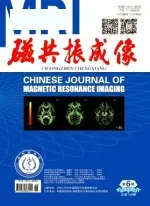侵袭性血管黏液瘤一例
赖云耀,袁 涛,杜湘珂
LAI Yun-yao, YUAN Tao, DU Xiang-ke
1.北京大学人民医院放射科,北京 100044
1Department of Radiology, Peking University People's Hospital, Beijing 100044, China
2.福建省宁德市医院放射科,宁德 352100
2Department of Radiology, Ningde municipal Hospital, Ningde city, Fujian province 352100, China

图1 CT增强重组矢状面图像示肿块跨盆膈生长,邻近结构受压移位,肿块内见条片状脂肪密度影,病变轻度强化,内见多发条索状影 图2~5 MR平扫T1WI冠状面、T2WI轴面及增强扫描T1WI矢状面、冠状面示肿块跨盆膈生长,呈不均匀强化,病灶内有旋涡状或分层样结构 图6 病理示瘤细胞呈梭形,间质水肿及黏液变性,血管丰富(HE×40)Fig. 1 Sagittal enhanced CT image shows large mass with fatty hypoattenuation in the superior portion traverses the pelvic diaphragm. Fig. 2—5 Coronal unenhanced T1-weighted MR image (2), Axial unenhanced T2-weighted MR image (3), Sagittal gadolinium-enhanced T1-weighted MR image (4), Coronal enhanced T1-weighted MR image (5). MRI images reveal large tumor with transdiaphragmatic extension presences a swirling or layered appearance and the enhanced strands of fibrovascular tissue accentuate the appearance. Nearby bladder and uterus are displaced to right. Fig. 6 Pathologic photomicrograph shows scattered spindle cells and abundant vessels embedded in a myxoid matrix.
患者 女,36岁,14年前发现左侧臀部肿物,直径约2 cm,突出于皮面,无红肿热痛表现,于13年前在外院行体表肿物切除术后,考虑为纤维血管瘤。切除后肿物复发并逐渐增大,3年前CT检查提示阴道占位。发病后大便次数增多,无发热腹痛。体检:一般状况好,腹壁柔软,无压痛及反跳痛,腹肌无紧张。左侧臀部可见直径约10 cm半球形隆起,质软,无波动感,可活动,无红肿热痛。
CT表现:盆腔左侧巨大密度不均匀肿块,条片状脂肪密度并实性软组织成分(平扫CT值约26~46 HU,轻微强化),膀胱、子宫及直肠受压右移,肠系膜根部多发肿大淋巴结(图1)。
MRI表现:肿块内信号不均,上部可见不规则条片状高信号、抑脂像呈低信号,中下部相对于肌肉呈稍短T1、长T2信号,矢状面及冠状面示其内多发纵向走行的小条带状稍低信号影,横断面示呈分层漩涡状,增强后呈不均匀强化,并见肿块内小条带状强化,膀胱、子宫及直肠受压右移,余与CT所见相同(图2~5)。
术中所见:盆腔内巨大肿块,向后蔓延至骶前区域,并沿坐骨大孔向后方,于盆底区形成巨大软组织包块,大小约18 cm×15 cm×15 cm,质软,色暗红,与周围脏器粘连。
病理所见:梭形细胞肿瘤,大小为24 cm×18 cm×4 cm,间质水肿及黏液变性,血管丰富。诊断为侵袭性血管黏液瘤(图6).
侵袭性血管黏液瘤(aggressive angiomyxoma,AAM)是一种少见的间叶组织来源的良性肿瘤,含有黏液和血管成分,1983年由Steeper和 Rosai[1]首次描述,具有“侵袭性 ”和“复发性 ”的特点[2]。临床所见患者多无症状,肿瘤生长缓慢,发现时病灶常常较大、直径多超过5 cm,常可跨盆膈生长,可累及周围脂肪、纤维或肌肉组织。病灶表达雌、孕激素受体,可能有激素依赖性[3]。
年龄、性别分布:该病90%发生于女性,20~40岁多见。好发部位:盆腔、会阴、外阴部和臀部。治疗:手术切除。预后:较好,未见远处转移的报道。
[References]
[1] Steeper TA, Rosai J. Aggressive angiomyxoma of the female pelvis and perineum: report of nine cases of a distinctive type of gynecologic soft-tissue neoplasm. Am J Surg Pathol, 1983, 7(5): 463-475.
[2]. Outwater EK, Marchetto BE, Wagner BJ, et al. Aggressive angiomyxoma: findings on CT and MR imaging. AJR Am J Roentgenol, 1999, 172(2): 435-438.
[3] Mccluggage WG, Patterson A, Maxwell P. Aggressive angiomyxoma of pelvic parts exhibits oestrogen and progesterone receptor positivity. J Clin Pathol, 2000, 53(8):603-605.

